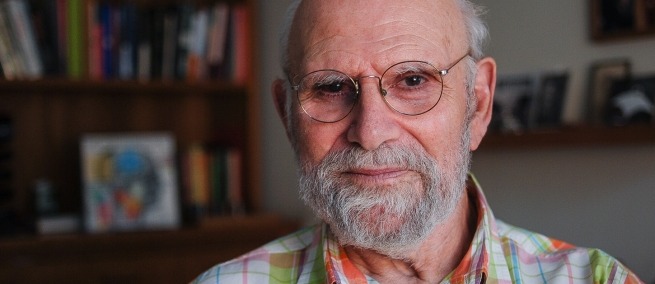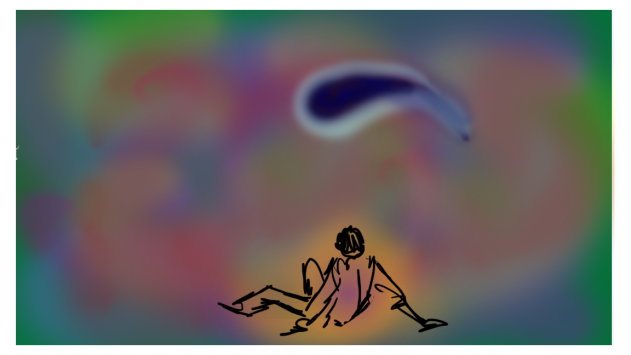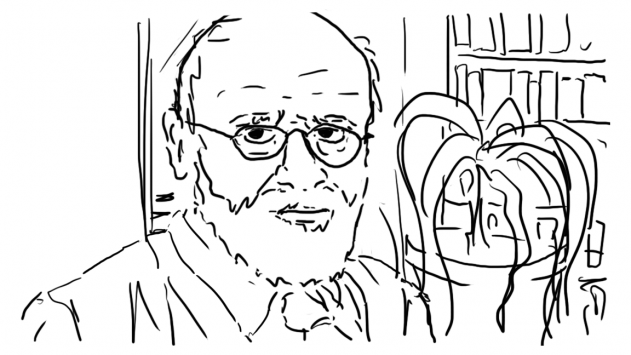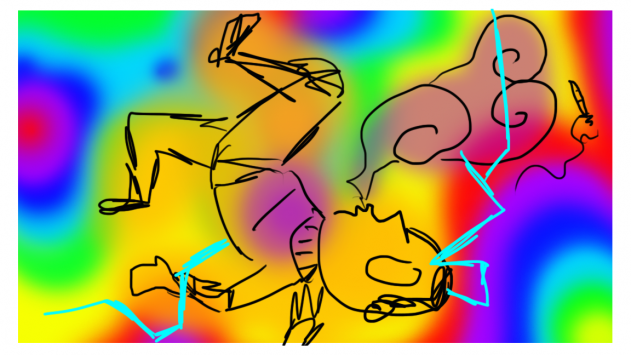
The late and great neurologist Dr. Oliver Sacks is remembered through his prolific writings and his tremendous empathy for his patients. A series of short animated documentaries, THE ANIMATED MIND OF OLIVER SACKS, tell the story of Dr. Sacks through his own stories of his patients: a synesthete who sees blue at the sound of D-Major, a prosopagnosic who can’t recognize faces, and an amnesic brought to life by a Grateful Dead concert. Ultimately, he himself is the patient; Dr. Sacks struggled with prosopagnosia and ocular melanoma, which literally affected his view of the world. Creator, director, and producer Dempsey Rice videotaped interviews with Dr. Sacks beginning in 2003 when she was a producer for the public radio program The Infinite Mind. Kate Edgar, who worked with Dr. Sacks throughout his life, is executive producer, and Joanne Nerenberg is co-producer. Science & Film corresponded with Dempsey Rice about the film:
Science & Film: When did you first realize that you wanted to make this film?
Dempsey Rice: I started interviewing Oliver in 2003. We would get together periodically and talk about his latest interests, particularly when he had a new book coming out. I’m not entirely sure when I realized that I might be able to build a film out of the material but it wasn’t until early 2015 that I realized that it was time to move forward.

S&F: What kind of support have you received so far? How have you worked together with Kate Edgar, who worked with Dr. Sacks for so much of his career?
DR: There was no working with Oliver without working with Kate Edgar! Kate was absolutely a guide through my time with Oliver and is now an Executive Producer of THE ANIMATED MIND OF OLIVER SACKS.
THE ANIMATED MIND OF OLIVER SACKS was recently part of the IFP’s Screen Forward Lab, an incubator for creators of serialized content. As a result of that Lab, I will also be at IFP Film Week in September. I have raised a few small grants and I’m preparing to pitch a few digital outlets in hopes of garnering funding and distribution for the series of 8-12 minute short films.
S&F: Why did you decide on this story-telling format?
DR: Oliver claimed not to have any ability to visualize in his own mind; instead, he built worlds out of words. As a filmmaker, I am interested in building a visual world for a man without internal vision. Animation allows me to build that world. I can illustrate stories, visually explore intangible subjects (neurology, neurological dis/function, memory, the mind), represent the role of words and language in Oliver’s life and represent the joyous curiosity that he embodied.

Oliver had a very boyish quality about him. He was so incredibly enthusiastic and had so much fun exploring the world. Animating Oliver also gives me the opportunity to explore some of that whimsy.
S&F: Who do you see as your audience? How do you think the film will be received by the scientific community, especially given Dr. Sacks' somewhat unorthodox use of psychotropic drugs?
DR: My primary audience starts with Oliver’s robust and loyal fan base: curious individuals interested in Oliver’s uniquely insightful, scientific stories. Oliver’s reading audience grew in number throughout his career—each book attracting new interest, based on its medical subject and reach, each article inviting more people into his world. The series of opinion pieces he published in The New York Times in 2015 on the subject of his dying captivated experienced Sacks readers and those new to the magic of his prose. These editorials exponentially increased interest in Oliver’s work.

An animated series of Oliver Sacks shorts done with playfulness, humor, and innovative visual interpretation has the potential to go deep into the digital sphere. WNYC’s Radiolab and blog/social media juggernauts like Brainpickings and I Fucking Love Science have broadened Oliver’s appeal and helped to introduce him to a younger audience. I expect THE ANIMATED MIND OF OLIVER SACKS to travel far and wide in the digital universe, spurred by ardent Oliver Sacks fans who are eager to see and hear more of him and share these animated stories.
My goal as a filmmaker is to make work that is true to who Oliver was. I don’t think that the scientific community will have difficulty with that. Oliver isn’t the only scientist to ever use psychotropic drugs for research purposes, in pursuit of knowledge, etc. He was open about it and didn’t receive criticism for it as far as I’m aware. It’s important to note that the use of drugs was one small part of Oliver’s life and it had little to do with his contribution to scientific literature.
S&F: What did you learn from interviewing Dr. Sacks over the years?
DR: It was an honor and a privilege to spend ten years interviewing Oliver Sacks. In his work, I find validation of my own belief in the power of hearing and documenting people’s stories. I was consistently awed by Oliver’s vast knowledge and his unique ability to leapfrog through different subjects. I was exposed to one of the most curious and intelligent minds I’ve ever met, and was deeply affirmed and inspired.
THE ANIMATED MIND OF OLIVER SACKS is currently in production and is part of the second annual Screen Forward Lab, which is the Independent Filmmaker Project’s (IFP) yearlong fellowship which awards $10,000 in services and support. Amy Dotson, the Deputy Director & Head of Programming at IFP leads the Lab; it runs through April 2017.
Storyboard images: Lucian Stern
Photograph: Dempsey Rice